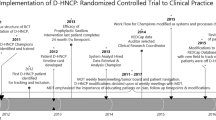Abstract
The study considered the feasibility and impact of interdisciplinary telemedicine discussions in the management of post-treatment dysphagia in patients with head and neck tumors. This is a retrospective analysis of patients with persistent dysphagia after treatment for head and neck pathology, at an institute in India. The cases were discussed in the telemedicine meeting conducted between host institute and a second unit in the United States. A monthly meeting was organized, using an internet-based video conference system. The ongoing swallowing problems and management were presented, and through discussions, a plan for further management was formulated and carried out. The Functional Oral Intake Scale (FOIS) was measured before and after the implementation of the plan. Twenty-six patients were discussed, out of which, 22 were head and neck malignancies. The recommendations concurred with that of the host unit in 18, differed for three and additive in five patients. The pre-treatment mean FOIS was 1.46 with a standard deviation of 0.989 and post-treatment mean improved to 3.92 with a standard deviation of 1.809 (p < 0.0001). The present study supports the success of an interdisciplinary telemedicine meeting to manage difficult cases of dysphagia in head and neck. The outcome in terms of the FOIS score improved significantly after implementing them. In addition to the direct patient benefits, the meeting helped to facilitate interdepartmental collaboration between two units treating similar sets of patients across the globe, in specialized clinical areas like dysphagia management.

Similar content being viewed by others
References
Logemann JA, Pauloski BR, Rademaker AW, Colangelo LA. Speech and swallowing rehabilitation for head and neck cancer patients. Oncology (Williston Park). 1997;11(5):651–6.
Watanabe SM, Fairchild A, Pituskin E, Borgersen P, Hanson J, Fassbender K. Improving access to specialist multidisciplinary palliative care consultation for rural cancer patients by videoconferencing: report of a pilot project. Support Care Cancer. 2013;21(4):1201–7.
Burns CL, Ward EC, Hill AJ, Malcolm K, Bassett L, Kenny LM, Greenup P. A pilot trial of a speech pathology telehealth service for head and neck cancer patients. J Telemed Telecare. 2012;18(8):443–6.
Heneghan C, Sclafani AP, Stern J, Ginsburg J. Telemedicine applications in otolaryngology. IEEE Eng Med Biol Mag. 1999;18(4):53–62.
Molini-Avejonas DR, Rondon-Melo S, Amato CA, Samelli AG. A systematic review of the use of telehealth in speech, language and hearing sciences. J Telemed Telecare. 2015;21(7):367–76.
Mashima PA, Brown JE. Remote management of voice and swallowing disorders. Otolaryngol Clin N Am. 2011;44(6):1305–16.
Ward EC, Burns CL, Theodoros DG, Russell TG. Impact of dysphagia severity on clinical decision making via telerehabilitation. Telemed J E Health. 2014;20(4):296–303.
Georges J, Potter K, Belz N. Telepractice program for dysphagia: urban and rural perspectives from Kansas. ASHA Lead. 2006;11:12.
Wall LR, Ward EC, Cartmill B, Hill AJ, Porceddu SV. Examining user perceptions of SwallowIT: a pilot study of a new telepractice application for delivering intensive swallowing therapy to head and neck cancer patients. J Telemed Telecare. 2017;23(1):53–9.
Ward EC, Burns CL, Theodoros DG, Russell TG. Impact of dysphagia severity on clinical decision making via telerehabilitation. Telemed J E Health. 2014;20(4):296–303.
Sharma S, Ward EC, Burns C, Theodoros D, Russell T. Assessing dysphagia via telerehabilitation: patient perceptions and satisfaction. Int J Speech Lang Pathol. 2013;15(2):176–83.
Sharma S, Ward EC, Burns C, Theodoros D, Russell T. Assessing swallowing disorders online: a pilot telerehabilitation study. Telemed J E Health. 2011;17(9):688–95.
Crary MA, Mann GD, Groher ME. Initial psychometric assessment of a functional oral intake scale for dysphagia in stroke patients. Arch Phys Med Rehabil. 2005;86(8):1516–20.
Friedland PL, Bozic B, Dewar J, Kuan R, Meyer C, Phillips M. Impact of multidisciplinary team management in head and neck cancer patients. Br J Cancer. 2011;104(8):1246–8.
Birchall M, Richardson A, Lee L. Eliciting views of patients with head and neck cancer and carers on professionally derived standards for care. BMJ. 2002;324(7336):516.
Logemann JA, Pauloski BR, Rademaker AW, Colangelo LA. Speech and swallowing rehabilitation for head and neck cancer patients. Oncology (Williston Park). 1997;11(5):651–6.
Hutcheson KA, Lewin JS. Functional outcomes after chemoradiotherapy oflaryngeal and pharyngeal cancers. Curr Oncol Rep. 2012;14(2):158–65.
Wall LR, Ward EC, Cartmill B, Hill AJ. Physiological changes to the swallowing mechanism following (chemo)radiotherapy for head and neck cancer: a systematic review. Dysphagia. 2013;28(4):481–93.
Rosenthal DI, Lewin JS, Eisbruch A. Prevention and treatment of dysphagia and aspiration after chemoradiation for head and neck cancer. J Clin Oncol. 2006;24(17):2636–43.
Mair F, Whitten P. Systematic review of studies of patient satisfaction with telemedicine. BMJ. 2000;320(7248):1517–20.
Dorrian C, Ferguson J, Ah-See K, Barr C, Lalla K, van der Pol M, McKenzie L, Wootton R. Head and neck cancer assessment by flexible endoscopy and telemedicine. J Telemed Telecare. 2009;15(3):118–21.
van den Brink JL, Moorman PW, de Boer MF, Hop WC, Pruyn JF, Verwoerd CD, van Bemmel JH. Impact on quality of life of a telemedicine system supporting head and neck cancer patients: a controlled trial during the postoperative period at home. J Am Med Inform Assoc. 2007;14(2):198–205.
Acharya RV, Rai JJ. Evaluation of patient and doctor perception toward the use of telemedicine in Apollo Tele Health Services, India. J Family Med Prim Care. 2016;5(4):798–803.
Author information
Authors and Affiliations
Corresponding author
Ethics declarations
Conflict of interest
The authors declare that they have no competing interests.
Rights and permissions
About this article
Cite this article
Mayadevi, M., Thankappan, K., Limbachiya, S.V. et al. Interdisciplinary Telemedicine in the Management of Dysphagia in Head and Neck. Dysphagia 33, 474–480 (2018). https://doi.org/10.1007/s00455-018-9876-9
Received:
Accepted:
Published:
Issue Date:
DOI: https://doi.org/10.1007/s00455-018-9876-9




